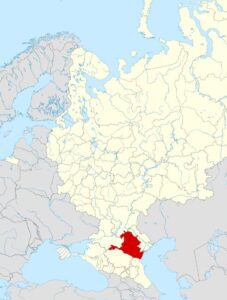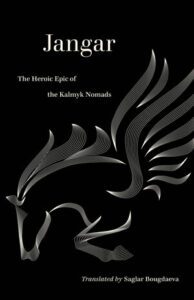
This is the first English translation of Jangar, the heroic epic of the Kalmyk nomads, who are the Western Mongols of Genghis Khan’s medieval empire in Europe. Today, Kalmykia is situated in the territory that was once the Golden Horde, founded by the son of Genghis Khan, Juchi. Although their famed khanates and cities have long since disappeared under the sands of the Great Eurasian Steppe, the Kalmyks have witnessed, memorized, and orally transmitted some of the most transformative developments, both victorious and tragic, in the history of civilizations. A tribute to the protectors of the mythical country Bumba, Jangar reflects the hopes and aspirations of the Kalmyk people as well as their centuries-long struggle for their cultural existence.
Saglar (Saga) Bougdaeva was born and raised in Kalmykia. Central to Bougdaeva’s work as a scholar of the Eurasian studies is a commitment to identifying and preserving the nomadic oral and written heritage of the Great Eurasian Steppe. Before receiving a PhD in Sociology from Yale University, Bougdaeva studied Mongolian-Tibetan-Mandarin linguistics at Saint Petersburg State University.

Can you tell us about your background and what motivated you to work on an English translation of this work?
I grew up in the Republic of Kalmykia, a Mongolic-speaking region on the Volga River and Caspian Sea. In ancient and medieval times, Kalmyks were called Oirads. From the nomadic perspective, this location was the most western post of the Eurasian steppe road. That western frontier was associated with one of the names of the West Wing polity of the Oirads, known as the Jungar Khanate (Jun means left and Gar means hand).
If we think beyond the recent modernist and nationalist Russian terms and expand our time frame, Kalmykia is located at the point where west meets east and east meets west. As both Asian and European agents of Eurasian cultural transmission, Oirad nomads easily crossed manmade borders not only geographically, but also conceptually and linguistically. All their aesthetic creations were valuable for that capability of polyglossia. They absorbed a myriad of influences without losing their own nomadic core, forming a multi-cultural buffer zone along the Eurasian steppe.
There are many perspectives on this particular region and field, but what is missing are the voices of the nomads themselves. Nomads seem to be incompatible with the Russian autocratic regimes and were hastily claimed to be dead by the Russian despotic rulers – such as bloody Katherine the II (who is not so Great) in 1771, Stalin in 1943, and now Putin. Yet remarkably, these empires of blood, steel, and abuse crumble while nomads still herd their ancient buffalo-like bulls, drink their Kalmyk tea together with their Christian and Muslim neighbors, happily dance, sing and write their epic histories.
Ultimately, I could not write about and translate anything else. I hope to change our understanding of the Eurasian nomads by translating their oral and written materials in a way that is true to their own nomadic aesthetic and intellectual values.
What factors did you keep in mind when translating this into English?
Nomadic empires have dramatically altered the cultural world of the Eurasian steppe. The Kalmyk-Oirad language of the Jungar Khanate, which is known as the last nomadic empire, remains largely overlooked by current research and publishers. However, when placed in the continuity of imperial nomadic dynasties, the Kalmyk-Oirad language offers an essential link to understanding nomadic polities and cultures.
In my research of nomadic aesthetics through archaic Oirad-Kalmyk words, I found continuity with early nomad empires and multi-linguistic traditions. The social life of the Oirads illustrates the broader steppe aesthetics and sensibilities. Moreover, Oirads were not the first Mongolic-speaking nomads at the West Wing post of the Eurasian steppe road. For example, in the sixth century, when Mongolic-speaking Avars from the Rouran Khanate lost their power to the Turks, they were chased from the east all the way to the Caspian Sea. One day in 558, the entire city of Constantinople gathered to see the foreign Avars. The Constantinopolitans were fascinated by the Avars’ unique fashion. The Avar men wore their hair long in the back, tied with ribbons and braided, and dressed in the Hunnu-style exquisite silk robes. As Walter Pohl rightly pointed out, the Avars dominated the Eurasian steppe road for two centuries as one of the powerful nomadic empires, but historians still do not know about this Mongolic speaking khanate.
Indeed, the field is understudied and needs more public attention. As culture carriers of the last nomadic empire, the Oirads offer us a translational bridge to the past khanates. For example, take the Avar hairstyle fashion depicted on the belt buckles across Eurasia, as explained in one of the Oirad epics:
Daini-Kurul-the Wrestler
folded his hair, massive as a camel,
braided in a wiggly black rope and seventy narrow braids,
pulled his hair back, twisting in a bun, and secured with a light yellow band.
A traveler would marvel his bun
and a lazy person would not be able to untie it.
All Avar free men and women wore distinctive large earrings fashioned from the pure gold or silver of melted coins. As I was working on this translation, I happened to stumble upon such Avar earrings on display at the Metropolitan Museum. Here is how the style is described in Jangar:
Swaying on her delicate earlobes were silver earrings
Which cast silver rays of light on the white tenderness of her neck.
If you saw the cute roundness of baby camel poop,
Then you probably can understand the earring design in its shape.
It is widely assumed that nomads were neither aesthetically developed nor literate. I disagree with that position. When I read Jangar, I heard nomadic voices of heroic humans, horses, birds, half-human giants, and semi-gods. I found my comfort in nomadic shelters: impeccably white tents and marvelous summer and winter residence-palaces. I visited nomadic cities, bazaars and public plazas for meetings and festivals, glass towers in the shape of eagles for elite women, suburbs for working people and servants. I travelled through the roads with planted poplar trees that connected seventy khanates of the Bumba union. Clearly the social worlds of nomads were very different from what is generally known about them.
What were some of the challenges of translating this work?
Russian propaganda presents quite a challenge to this work. What we know about the vast territories and populations across the Eurasian steppe road, from the wall of Beijing to the wall of Berlin, is in the hands of the Russian government. Our knowledge about existing polities is scarce, and our knowledge about destroyed nomadic polities is even more threatened.
There is a link between literature and political freedom. It is not surprising that the Oirad-Kalmyk aesthetics of literary creation are seen as a direct threat to Russian state building. First, Muscovites and later Soviet and post-Soviet authorities worked hard to spread propaganda that Eurasian nomads are illiterate and do not have their own sovereign polities and literature.
However, archeological and literary evidence challenges this propaganda. Since the nomadic perspective is understudied for these political reasons, there is a demand to begin with the foundational basics – identifying and translating indigenous sources into English and making them available to a wider readership. When literature escapes the regime and is shown to the world, it is harder for the Russian authority to suppress the voices of freedom and humanity.
How would you describe the style of the epic?
Jangar is a meditative imagination. As in dreams, there is not a strong sense of time. In the absence of time, movement is captured in relation to memorable events, such as a compelling call for a heroic act.
In reading Jangar, our mind merges with a hero, who is a moving point in space; they become a hero while navigating the Eurasian steppe road. Along this road, which stretches between the Mingi (Caucasus) and the Ganga (Ganges), the epic pinpoints the Altai Mountains as the original homeland of the Oirad-Kalmyks.
The basis of Jangar’s creation is the unification of individual heroic songs. In every song, a hero lives through their individual cycle; a hero begins and ends their heroic adventure in Altai, in the Bumba banquet hall with drinking, feasting, and merry-making. Every song evolves around a central axis, the Bumba union of khanates and their united identity.
This cyclization reflects the Kalmyk collective processes in which Bumba is a symbol of the nomadic polity in its ideal form. In the time of destruction, Jangar offers a meditative imagination, helping to transform a world of suffering into a world of peace and joy. In the time of social change, Jangar offers a way to imagine how to achieve a heroic self and build a united heroic being.
What is one of your favorite scenes from the book?
Jangar is very much about feelings and sensibilities. My favorite feeling from the book is the sense of freedom of global travels, from east to west and back again. This archaic language allows us to become witnesses to the global movement along the Great Steppe Road. The quintessential elements of this exciting global flow of people were groundwater well (ulgen) stops, “tea and sleep” (chai-honna) stops, diners (khotan), soup kitchens (sholun) for monks and the poor, horse-exchange and postal stations (yam), watchtowers and storm shelters (bolzatin boro), golden and silver bridges over rivers, and jade gates marking the entrances and exits of khanates.
I was also delighted by the depictions of women in Jangar. In the epic, women are powerful agents of their own lives. If they want to be free, they fight for their right to be free. If they want to love, they fight for their right to love. Nothing and no one stand on their way. They crash every obstacle or die.
What do you hope readers will take away from the book?
Jangar was expressed by heart and memory. Treasures of nomadic art and literature were expressed in ways that made sense to nomadic cultures but are unexpected for a modern reader. For example, if you decide to live in a mobile home called ger, it makes more sense to leave wall paintings behind and bring exquisite carpet art, which you can roll out and find more value in its utility.
Similarly, if treasures of “literature” are not written with black ink on white paper, but express an exquisite aesthetic of creative narration, shouldn’t we celebrate it based on its brightness and not its format?
Today, the problem with our definition of literature is its focus on written works. It means we often throw out whatever is outside of that frame. Jangar is only one of many examples of what we have almost lost.
